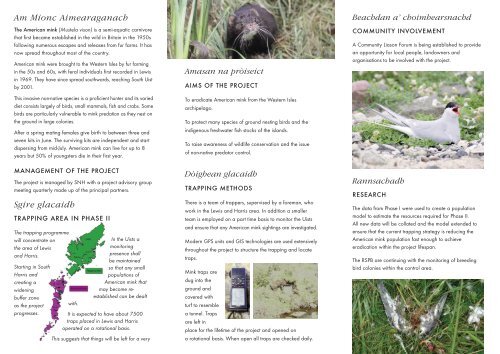Scotland's Wildlife
Scotland's Wildlife
Scotland's Wildlife
Create successful ePaper yourself
Turn your PDF publications into a flip-book with our unique Google optimized e-Paper software.
Am Mionc Aimearaganach<br />
The American mink (Mustela vison) is a semi-aquatic carnivore<br />
that first became established in the wild in Britain in the 1950s<br />
following numerous escapes and releases from fur farms. It has<br />
now spread throughout most of the country.<br />
American mink were brought to the Western Isles by fur farming<br />
in the 50s and 60s, with feral individuals first recorded in Lewis<br />
in 1969. They have since spread southwards, reaching South Uist<br />
by 2001.<br />
This invasive non-native species is a proficient hunter and its varied<br />
diet consists largely of birds, small mammals, fish and crabs. Some<br />
birds are particularly vulnerable to mink predation as they nest on<br />
the ground in large colonies.<br />
After a spring mating females give birth to between three and<br />
seven kits in June. The surviving kits are independent and start<br />
dispersing from mid-July. American mink can live for up to 8<br />
years but 50% of youngsters die in their first year.<br />
MANAGEMENT OF THE PROJECT<br />
The project is managed by SNH with a project advisory group<br />
meeting quarterly made up of the principal partners.<br />
Sgire glacaidh<br />
TRAPPING AREA IN PHASE II<br />
The trapping programme<br />
will concentrate on<br />
the area of Lewis<br />
and Harris.<br />
Starting in South<br />
Harris and<br />
creating a<br />
widening<br />
buffer zone<br />
as the project<br />
progresses.<br />
with.<br />
In the Uists a<br />
monitoring<br />
presence shall<br />
be maintained<br />
so that any small<br />
populations of<br />
American mink that<br />
may become reestablished<br />
can be dealt<br />
It is expected to have about 7500<br />
traps placed in Lewis and Harris<br />
operated on a rotational basis.<br />
This suggests that things will be left for a very<br />
Amasan na pròiseict<br />
AIMS OF THE PROJECT<br />
To eradicate American mink from the Western Isles<br />
archipelago.<br />
To protect many species of ground nesting birds and the<br />
indigenous freshwater fish stocks of the islands.<br />
To raise awareness of wildlife conservation and the issue<br />
of non-native predator control.<br />
Dòighean glacaidh<br />
TRAPPING METHODS<br />
There is a team of trappers, supervised by a foreman, who<br />
work in the Lewis and Harris area. In addition a smaller<br />
team is employed on a part time basis to monitor the Uists<br />
and ensure that any American mink sightings are investigated.<br />
Modern GPS units and GIS technologies are used extensively<br />
throughout the project to structure the trapping and locate<br />
traps.<br />
Mink traps are<br />
dug into the<br />
ground and<br />
covered with<br />
turf to resemble<br />
a tunnel. Traps<br />
are left in<br />
place for the lifetime of the project and opened on<br />
a rotational basis. When open all traps are checked daily.<br />
Beachdan a’ choimhearsnachd<br />
COMMUNITY INVOLVEMENT<br />
A Community Liason Forum is being established to provide<br />
an opportunity for local people, landowners and<br />
organisations to be involved with the project.<br />
Rannsachadh<br />
RESEARCH<br />
The data from Phase I were used to create a population<br />
model to estimate the resources required for Phase II.<br />
All new data will be collated and the model extended to<br />
ensure that the current trapping strategy is reducing the<br />
American mink population fast enough to achieve<br />
eradication within the project lifespan.<br />
The RSPB are continuing with the monitoring of breeding<br />
bird colonies within the control area.

















